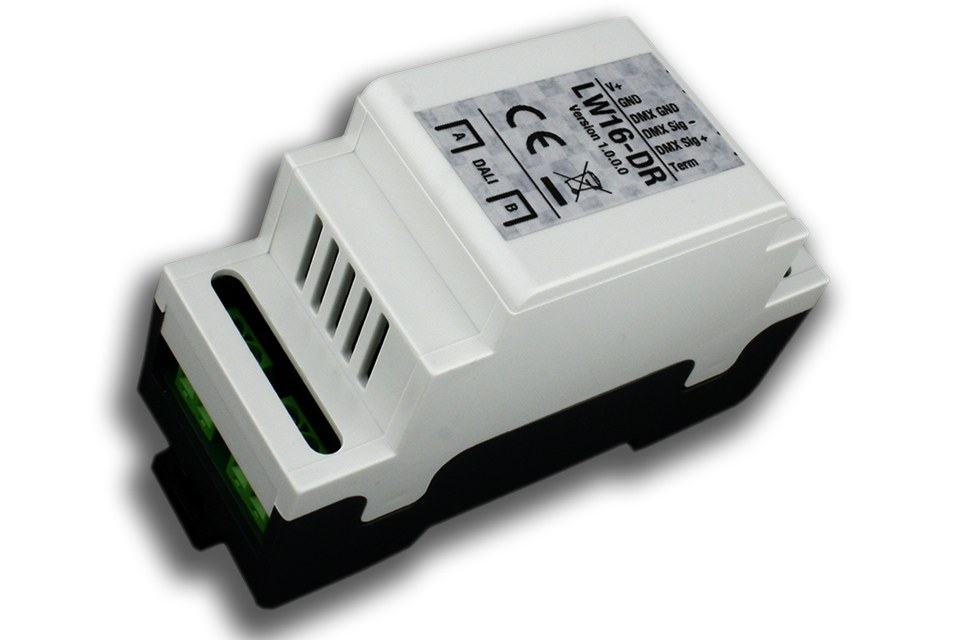Code Mercenaries Releases DMX/RDM to DALI Bridge
Code Mercenaries is proud to introduce its LED-Warrior16, a DMX/ RDM to DALI bridge. The LED-Warrior16-DR converts DMX/RDM lighting control data into DALI commands. This allows to control DALI luminaires from a DMX/RDM bus. The LED-Warrior16 comes in an enclosure for mounting on a DIN rail. It requires a 7 V to 26 V DC power supply with 30 mA max.
Technical Data:
• DMX/RDM to DALI bridge
• Broadcast, group, or individual addresses
• 1 to 16 groups, 1 to 64 individual addresses
• 7 - 26 V power required, max. 30 mA
• Enclosure for DIN rail mounting
LED-Warrior16 converts the brightness data from the DMX/RDM bus into commands for the DALI bus. Either individual DALI luminaires, groups, or all luminaires on the DALI bus can be addressed. 1 to 16 groups, or 1 to 64 individual luminaires can receive their individual brightness value.
Configuration of LED-Warrior16 is done via the bidirectional RDM protocol. Standard tools may be used to do this. Start slot, mode and number of groups or luminaires are configurable.
Quick Installation:
To install the LW16-DR on a DIN rail just gently push it onto the rail until it locks. No tools are required for mounting. Removing LW16-DR from the DIN rail is done by gently pulling one of the locking levers using a screwdriver or similar tool.
Connecting to the DALI bus is done via the terminal blocks. There are two positions in each of the blocks. The positions in a block are identical and intended for easy daisy chaining. Connect the DALI bus lines one to each of the blocks. LW16-DR needs a DC power of 7 V to max. 26 V at max. 30 mA. The DC power is connected to "V+" and "Gnd". Observe the polarity!
The DMX/RDM bus is connected to the terminals "Sig+" and "Sig-". Observe the polarity of the signal! The bus termination should be enabled if LW16-DR is the last device on the bus. To do this insert a jumper between "Sig+" and "Term". Attention: None of the signals of LED-Warrior16-DR may be connected to mains voltage!
Simple Configuration:
Configuration of LW16-DR is done via the RDM bus with any standard RDM configuration tool. The start slot and personality settings control the behaviour of LW16-DR. The start slot selects the first DMX/RDM data slot that gets converted to DALI. The personality allows to select the number of slots to be used and which addressing mode is to be used.
Factory setting is that LW16-DR uses the first slot and converts it into a broadcast command. So in this mode all DALI devices are set to the brightness defined by the first slot.
Alternatively 1 to 16 slots can be used to control the DALI groups, or 1 to 64 slots to control the individual DALI devices. The first slot always goes to the group 0 or device zero, the next slots go to the next groups/devices until the maximum number selected by the personality setting.
Important Note:
Since the data rate on DALI is significantly lower than on DMX/RDM it can happen that only the last received brightness value is transmitted on DALI.
The DALI bus needs a DALI bus power supply for operation. The DALI bus has to be configured if any addressing beyond broadcast should be used.
For additional information, please visit www.codemercs.com/en/, and for further questions please contact Code Mercenaries at sales@codemercs.com
About Code Mercenaries:
Code Mercenaries is a supplier for the industrial input device and peripheral market since 1998. In 2008 Code Mercenaries started to develop and manufacture products for LED lighting applications. For the lighting products we apply our product philosophy to provide solutions for certain technical problems to allow our customers to concentrate on their own strength in developing their end products.
Code Mercenaries' philosophy is to provide complete solutions that allow our customers to concentrate on their own strength in developiong their end products. The necessary know how for controlling interfaces like the USB or PS/2 is encapsulated in our chips so that the device manufacturer does not need to care about these details but rather can concentrate on what they can do best. Like a manufacturer does not need to care about details of USB but can fully devote their engineering to creating rugged and reliable keyboards.

